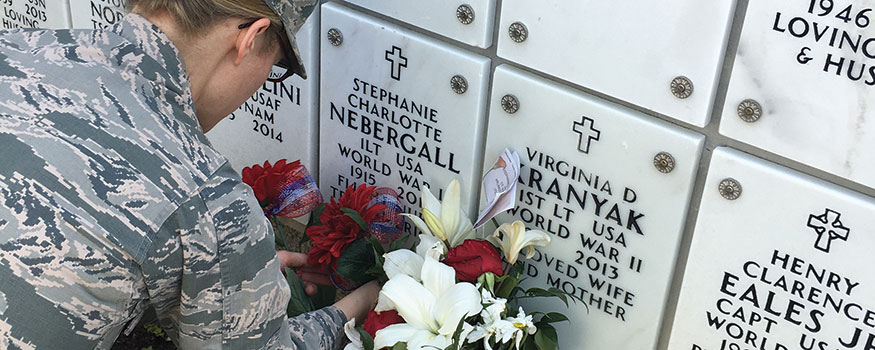Thirty years ago, Brigadier General Sarah Wells began the tradition of gathering nurses together to place flowers on the graves of nurses who served in the U.S. military and are buried at Arlington National Cemetery. This biannual tradition continues today.
Wells served as Air Force Nurse Corps Chief from 1979 to 1982.
Members of the Society of Air Force Nurses (SAFN) continue to honor military nurses who are buried at Arlington. During Memorial Day week, they place flowers on their graves; in December, they place wreaths. This year, approximately 32 active-duty and retired Air Force nurses placed red dahlia floral tributes on the 141 Arlington graves of military nurses. SAFNs demonstrate the commitment not to forget nurses who’ve served our nation faithfully.
This article highlights the contributions of two of those nurses—Stephanie Nebergall and Dorothy Mulhern.
1LT Stephanie Nebergall
(May 24, 1915 to July 7, 2013)
During World War II, more than 59,000 American nurses served in the Army Nurse Corps. In Franklin D. Roosevelt’s 1945 State of the Union Address, he described a critical shortage of Army nurses and stated that European-theater medical units were being strained to the breaking point. He proposed that nurses be drafted. A nurse draft bill then passed in the House and came within one vote of passing in the Senate before Germany surrendered later that year.
Stephanie Nebergall’s husband of 2 months was killed in a midair collision while serving in the Army on Christmas Eve 1943. According to Patty Brown, Nebergall’s daughter, “My mom said, ‘By God. No one is going to [have to] draft me!’” On May 1, 1945, Nebergall voluntarily enlisted in the Army as one of 10,000 nurses from the Greatest Generation to serve. Brown described her mother’s military service as second to none. “In those days, women pretty much stayed at home, but not my mom. She traveled the world so she could help people, especially our soldiers.”
Some of Nebergall’s favorite stories were about flying with wounded U.S. soldiers from Japan back to America. Once she helped transport a soldier in a full body cast. He was terrified the plane would crash and feared he would sink from the weight of his body cast. “My mom told him, don’t you worry. If the plane goes down, I will hold your hand and we will go down together.” They both made it back in one piece.
Nebergall’s family and friends will remember her as a strong, giving woman. Although regulations forced her to leave the military when she married her second husband, she later continued to work as a nurse. She retired as a nursery nurse at age 65, but continued to volunteer at Kaiser Permanente in Anaheim, California, until age 92. She remained an active member of SAFN until her death. Thanks to her influence, her nephew served (and since retired) as an Army Lt. Col. Green Beret. Her two great-grandsons currently serve in the U.S. Marine Corps.
LT Dorothy Mulhern
(June 19, 1926 to January 25, 2014)
Growing up on a farm in rural Pennsylvania Dutch country, Dorothy Mulhern enjoyed working with people and developed a desire to help others. She became an RN in November 1948. Mulhern was one of the first two nurses granted a direct commission in the USAF Nurse Corps Reserve after being certified as flight nurse in November 1950. She met her husband while stationed at Iceland Defense Force Hospital in 1951; they married in 1952. Mulhern was honorably discharged from the Air Force in 1953.
According to her husband, George Mulhern, she enjoyed flying with wounded soldiers from Korea to hospitals near their U.S. homes. She also worked with memory-scarred veterans as a psychiatric nurse at Boston Veterans Hospital, helping them rebuild their lives.
Mulhern’s military experiences were central to her many contributions later in life. She enjoyed working with patients from poverty-stricken areas of Philadelphia. She became a leader in the Assistance League of Los Altos, California, where she served three terms as president. Her leadership helped tackle difficult local problems. She also served as co-chair for the development committee of an apartment complex that provided low-cost housing for patients undergoing medical treatment at Stanford Medical Center in California. In addition, she was a long-time supporter of the Women in Military Service for America Memorial in Washington, DC. Her legacy lives on in the lives of her husband, three sons, grandchildren, and community.
Dedicated and selfless
Nebergall and Mulhern exemplify the dedication and selfless service representative of the other 139 nurses buried in Arlington. They continued to serve their communities and were greatly admired long after they took off their military uniforms.
Today, the women and men serving as military nurses still answer our nation’s call and provide superior care to all of America’s heroes. May we follow SAFN’s pledge to never forget the nurses who served, and continue to serve, our nation.
Vickie Hughes is an associate professor of nursing at Appalachian State University College of Health Sciences in Boone, North Carolina.


















